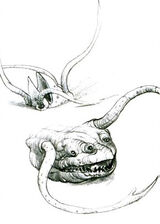| | |
- "In his belly, you will find a new definition of pain and suffering as you are slowly digested over a…thousand years."
- ―C-3PO translating for Jabba the Hutt
Sarlaccs were semi-sentient, plant-like, omnivorous creatures found on several planets across the galaxy. The Sarlaccs were unique among galactic species, having characteristics of both plant and animal, it spent most of its life underground with only its mouth visible from the surface. It lived to be tens of thousands of years old, and reproduced by spores.
One sarlacc was located in the Great Pit of Carkoon on Tatooine. It tortured the famous bounty hunter Boba Fett, who eventually escaped. While Jabba the Hutt claimed it as a pet, it arrived on Tatooine of its own accord. Another sarlacc could be found on Felucia. Near this sarlacc, Shaak Ti was slain by Darth Vader's secret apprentice, Galen Marek. A third sarlacc dwelled in the pit on the planet Aargonar's moon Aargonar 3. Yet another, less famous sarlacc dwelled on Tatooine next to some Ancient Ruins. It attempted to devour Darth Tyranus while he was dueling Anakin Skywalker, but the Count used the Force to escape and then fled from battle.
Lifespan[]
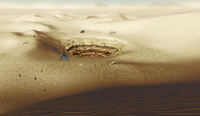
The Great Pit during the Cold War
The sarlacc had an estimated lifespan of 20,000 to 50,000 years. Younger members of the species could move under the sands rapidly and catch their prey, while older ones remained immobile, waiting for prey to stumble into their clutches. Females generally grew much larger than males, to the point that breeding required that the male attach itself to the female, being entirely dependent on their much larger companion. Adults generally had little to fear, as only the greater krayt dragon of Tatooine and the gouka dragon of Aargonar were known to prey upon them.[6]
One specimen of the species resided in the Great Pit of Carkoon, beneath the sands of the Dune Sea on the remote planet of Tatooine. Most sarlacci preferred damp environments, but they could live nearly anywhere including the desert sands of Tatooine.
The largest known sarlacc in galactic history resided on the planet Felucia within the Ancient Abyss. The Jedi Master Shaak Ti tamed this beast, and it assisted her in her duel with Starkiller. However, she lost the duel and was swallowed by the beast. It possessed massive tendrils and teeth that spread out over an area of the Abyss that was kilometers across. This sarlacc was capable even of using its tentacles to drag great beasts like rancors into its maw or to crush attackers. In 2 BBY, it was restrained by the Galactic Empire in order to hunt down the remaining Felucians, although it was later freed by a redeemed Starkiller.
Xenobiologists were unsure whether the sarlacc was animal or plant, as it possessed the characteristics of both kingdoms, but most scientists classified the sarlacc as a giant plant organism. Data taken from Boba Fett's helmet suggested that it was more like a plant.
Biology[]

A sarlacc's beak and tendrils
The sarlacc was a large, omnivorous invertebrate with long tentacles that rimmed its mouth. They reproduced by spores, known as sarlacci, that traveled through space until they found another suitable planet to inhabit. After implanting itself into the ground, the sarlacci grew downward like a plant, forming a pit. The mouth and tentacles were the most visible parts of the sarlacc. The rest of the sarlacc's massive anatomical features were buried up to one hundred meters deep in the ground. This guaranteed protection of the sarlacc's vital organs and made it invulnerable to most forms of serious damage. The teeth of the sarlacc surrounded its beak-like tongue and plant-like tentacles in tiers. Its teeth were also slightly slanted inward ensuring its prey would remain trapped. While its lightning-fast tentacles were used to snatch up its prey, such as eopies, they were not its primary means of capturing a meal. The sarlacc discharged odors and scents that lured herbivores and scavengers close enough for it to use its tentacles.[7] Sarlaccs had a very odd body shape. The sarlacc's mouth was the only part of the body visible, usually. Most of its body was covered in rigid plates. It had eight appendages beneath the ground used for stability or for reburial if the sarlacc became partially exposed. The body of the sarlacc ended in three roots used for moisture absorption.
Despite their size, sarlaccs did not need to eat very much at a time. They were almost entirely immobile, which means they had to be able to survive for prolonged periods without food. As a result, they also digested their food very slowly. It was even said that sarlaccs could be telepathic and could gain consciousness from the creatures they ate by assimilating their thoughts and memories during digestion.[7]
Anatomy[]
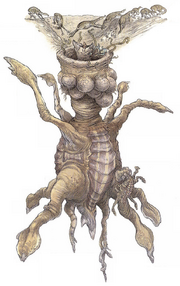
The underside of a sarlacc's body
- "Tentacular appendages can whip out and snare spectators from the rim of the pit, and inward-pointing spearlike teeth make escape impossible."
- ―Mammon Hoole
The sarlacc's body did not have a skeletal structure or a solid framework, but it did possess a strong muscular body with large roots and a series of nerve endings on its skin.
The sarlacc had roots on the outside of its body to leech the nutrients from the ground and to sense the vibrations from creatures on the desert sands. The sarlacc lacked eyes and ears, instead relying on the sensors in its roots to "see" its prey. The sarlacc's mouth contained large mucus-coated teeth and strong tentacles for catching prey. The tentacles grabbed prey and pulled them into its maw, whereas the inward-pointed teeth functioned to keep victims in the mouth.
The sarlacc had a large beak that emerged from the throat. The "beak," in reality, was the sarlacc's tongue, and the tongue within the tongue was actually yet another stubby tentacle that aided in swallowing prey. The sarlacc's throat had many veins and vessels which acted as sensors to determine the size, weight, and strength of the food, allowing the sarlacc to decide which stomach to put its prey into; stronger prey were put into the secondary stomachs, while smaller prey went into the main stomach.

The sarlacc's tongue, blindly flexing for its next meal
The sarlacc's throat possessed many microscopic openings that dispersed mucus to keep the throat healthy—the sand, gravel, or other debris (as environment varied from one sarlacc to another) that dropped into the mouth could damage the lining of the throat. The more the sarlacc ate, the more the stomachs ran out of room, and, in rare cases, it used a small number of its victims to grow the stomachs by enmeshing those few victims into the stomachs. The sarlacc also used small air holes around its mouth for breathing.
The sarlacc's roots functioned as tentacles during adolescence, and then grew into full immovable stalks during adulthood. They absorbed tiny fungal life forms, bugs, and microscopic cells and bacteria into the body from the ground for nutrients. The sarlacc's body could also absorb liquid molecules through small openings in the roots, to keep its water level up.
The tentacles on the mouth were actually thin strong tongues that could feel and taste the ground and prey. The beaks of other sarlaccs had other tongues within their beak that emerged to grab prey and directly pull them into its beak. The tentacles could stretch as far as four meters to grab meals.
Although sarlaccs were usually immense, some miniaturized versions of the species existed and were traded as pets, such as Phileas.[9]
Sarlacc vocalizations were high-pitched screeches. However, they did occasionally emit a loud belching sound when consuming prey.[5]
Digestive system[]
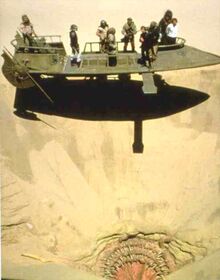
The sarlacc's gaping, teeth-lined maw, as seen from the surface
- "The sarlacc found me somewhat indigestible."
- ―Boba Fett
Only the sarlacc's gaping maw could be seen from the surface, with the vast majority of its huge body lying beneath the ground. It lay in wait for any living humanoid or creature to stumble into its maw, and additionally, it pulled nearby victims in with one of its many tentacles. A sarlacc's mouth was surrounded by rows of retractable razor-sharp teeth, used to chew victims during adolescence, before the digestive system was fully formed. Adult sarlaccs developed a beaked, snake-like tongue at the center of the fearsome pit, which doubled as an inner mouth.
Once the victim was swallowed, they fell into the sarlacc's stomach, deliberately being kept alive by the beast and digested extremely slowly for a millennium. The stomach walls were lined with tentacled vessels which punctured and embedded themselves into the prey's skin and muscles before fixing them into the walls. The tentacles then injected neurotoxins into them, causing constant pain and rendering them immobile while being fixed into the walls of the stomach and digested.
The vessels gave enough sustenance with the sarlacc's blood to enable its prey to live for centuries while they were digested. In addition to the acidic fluids that dissolved the outer portions of the meals, the sarlacc also processed them from within. The tendrils and vessels pumped the sarlacc's acidic blood into its meals and carried back nutrients from them. Occasionally, when a victim was digested for longer than usual, the sarlacc embedded them in the lining of the stomach to make room for other victims it swallowed. This was to make the stomach stronger.
Many smaller secondary stomachs were used to store prisoners for later consumption at times when the sarlacc needed larger amounts of nutrients, such as when it needed to grow, breed, or strengthen its tentacles and beak to catch stronger, larger prey. The secondary stomachs also functioned as a space to store victims when the main stomach ran out of room, although this was rare as the sarlaccs were an exceptionally feared creature in the galaxy. The acidic fluids in the stomachs were composed of weak chemicals that took much longer to digest its food than acids in the stomach of other creatures. They specifically targeted skin and muscle tissue, because that was where the nutrients in the food were. The secondary stomachs were also lined with more vessels and were smaller and more cramped to enclose the victims, so that the sarlacc did not have to deal with the meal trying to escape its hold. Only rare individuals such as Boba Fett resisted due to his tightly sealed armor.
Mating and spawning[]
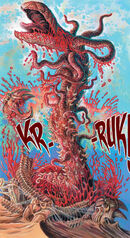
A sarlacc nearing the end of its larval stage
- "It was far more plant than animal."
- ―Unidentified Jedi Knight
A Sand People legend told of how the sarlacc gave birth to itself in Tatooine's planetary core in the days before the twin suns split apart from a single star. According to this legend, it would continue to eat everything it came in contact with until eventually it was forced to consume itself. Though this was not a true account of the sarlacc's origin, the Tuskens refused to accept any other explanation.
The male sarlacc was much smaller than the female, and typically attached itself to the female like an anglerfish. The pair would produce a number of minuscule larvae, very few of which made it to adulthood. However, on one occasion, a male sarlacc, which started off much smaller than a female made contact with a female, the male attached himself to her in a parasitic fashion. He gradually became larger as she became smaller. After several thousand years the female was digested into oblivion and he became the equivalent size of her, replacing the area where she once existed. The male then injected sperm into the spore-production sac. Afterwards, the melded couple released the fertilized spores, which could leave the atmosphere and travel long distances through the galaxy to other planets. Because of this fantastic ability to propagate, the species' point of origin was never accurately determined. Once the spore settled down, it attached itself to an organism and sucked blood from it to feed itself. After detaching, it developed into a more mobile larva and was able to hunt and consume prey.
As it grew, the voracious larva would eventually challenge larger creatures. If the sarlacc larva was consumed by a bigger creature, the larva would kill it and eat it from the inside, assuming its consumer had swallowed it in more or less one piece. During this stage, it developed into a large worm-like creature with many tentacles and a beak-like maw. Eventually, the larva would dig itself into a pit, growing roots to anchor itself in the ground while it grew into a full-sized sarlacc, becoming largely immobile and more plant-like. The roots also functioned to absorb additional nutrients from the ground as a precaution against shortages of prey. A larger mouth formed around the beak, which became more like a tongue.
Semi-sentience[]
- "Sarlacci do interesting things with messenger RNA: over the course of millennia, they can attain a sort of group consciousness, built out of the remains of people they've digested."
- ―Unidentified Jedi Knight
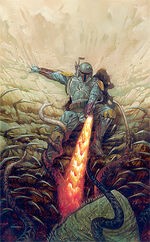
Boba Fett escaping the sarlacc's grasp
Jabba Desilijic Tiure sentenced Luke Skywalker and his companions to "death by sarlacc" in 4 ABY. Prior to his execution, Luke Skywalker retrieved his lightsaber from the astromech droid R2-D2 and freed his companions. In addition to numerous other casualties during the ensuing battle, Han Solo obliviously knocked the notorious bounty hunter Boba Fett into the pit with a force pike. However, Fett remained alive and—using his jetpack and weapons—blasted himself out later, becoming one of the only beings known to escape from a sarlacc's belly alive.
While studying a holographic recording recovered from Fett's helmet camera, Senior Anthropologist Mammon Hoole discovered an unsettling revelation: the beast apparently possessed the ability to telepathically torture its prey. In this recording, Fett appeared to be reacting to stimuli that did not exist, suggesting that sarlacc were capable not only of communication, but apparently of malevolence, feeding off the fears of their prisoners. This led Hoole to classify the sarlacc as a semi-sentient creature. It was also believed that the consciousnesses of the sarlacc's victims joined to create a huge network of awareness. The victims were able to communicate with one another through this ghoulish network. As the sarlacc absorbed the thoughts of its victims, it would become more and more intelligent, to the point where a sarlacc could almost predict what its victims would do in its stomachs to try and escape, or predict when it was hunting them.
Zorba the Hutt, who was swallowed by the sarlacc, was regurgitated shortly thereafter. According to Zorba, the reason for his survival was that no sarlacc could possibly hope to digest a Hutt.
Darth Vader's secret apprentice, Starkiller, was the only being known to have voluntarily journeyed inside a sarlacc, on Felucia. He survived the digestive mechanisms without being grabbed by them and escaped unharmed.
Another mysterious and unique incident occurred with the Tatooine sarlacc and a girl called Shaara. While she fell into the Great Pit of Carkoon, she was thrown back out before any attempt was made to digest her, unlike the stormtroopers that had given her chase. There were no clear reasons the sarlacc had spared her.
The sarlacc of Tatooine identified itself closely with one of its first victims, a Choi named Susejo. Susejo and the beast had seemingly merged in consciousness to the point where Susejo could control the actions of the sarlacc.
The fibrous vessels in the stomachs connected prey together. The digestive fluids and the sarlacc's blood traveled through the vessels and into the victims, which were connected in the manner of an electrical current, bringing the victims' minds, thoughts, bodies, and spirits together, keeping them at one with the sarlacc's body, brain, and soul.
Having long admired the patience of the sarlacc, the Jedi Order named a form of lightsaber combat, Shii-Cho, after the beast.
Known locations[]
- "It's rare for a sarlacci spore to survive a landing in a desert environment; they're best suited to wet environments, though they can survive almost anywhere."
- ―Unidentified Jedi Knight

The sarlacc in the Great Pit of Carkoon on Tatooine, with Luke about to be thrown in it
- Felucia
- Aargonar (Also present on Aargonar 3)[12]
- Chad
- Taanab
- Darvannis
- Dathomir[13]
- Duroon[14]
- Socorro
- Sarlacc's Peak
- Socorro sarlacc
- Tatooine[5]
Behind the scenes[]
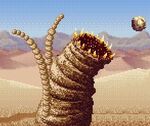
The Tatooine sarlacc as depicted in Super Star Wars
The sound of the sarlacc in Return of the Jedi was created from sounds of alligator hisses, as well as the sounds of some of the Jedi crew's stomachs after eating pizza.[15]
In the Special Edition of Return of the Jedi, the sarlacc in the Pit of Carkoon was revised to include a beak-like tongue and extra tentacles. According to Lucas, this was done because he never felt the creature seemed alive in the original film.
There are several depictions of the sarlacc's body that contradict one another. The Wildlife of Star Wars, for example, includes a sketch of a very plant-like sarlacc. This now appears to be the definitive Legends sarlacc. It has root-like limbs to anchor itself and collect water. It also has many chambers to store and digest food. Most other depictions are of a worm-like creature, with tentacles on the outside of its body. The Star Wars Tales story "Fortune, Fate, and the Natural History of the Sarlacc" appears to treat this depiction of the sarlacc as the creature's late larval stage. In the Super Nintendo game Super Star Wars, the sarlacc appears as the boss of the first stage, where it bursts from a screen-wide quicksand-like pit and attacks with two tentacles and by spitting rocks; this look is much more worm-like than other representations, though it still has the open mouth ringed with teeth. While the Tatooine sarlacc is the most well-known example and, consequently, sarlaccs are usually presented to be on Tatooine or in desert environments, these are exceptions since sarlacci prefer wet environments.
In Star Wars: Jedi Knight: Jedi Academy, on a multiplayer level (which is accessible in single player using the "Map" code)—duel 8, or "Abandoned City"—in a corner, what seems to be a sarlacc's tendrils are poking out of the ground. However it's unclear whether they're actually sarlacc tendrils, as in the game files the model is identified as "roots."
On April 1, 2010, BioWare announced that the Sarlacc Enforcer would be a playable class and species for their game Star Wars: The Old Republic. They even made a holonet page. This was later revealed to be an April Fool's joke.
A sarlacc can be seen in Star Wars: The Old Republic. Players on the Republic side can accept a Heroic Quest, which takes the player to the Dune Sea. There, the player must get past Gamorrean guards in order to drop an explosive in the sarlacc's mouth.
Appearances[]
Non-canon appearances[]
- Jedi Academy: Return of the Padawan (Mentioned only)
- LEGO Star Wars: The Complete Saga
- LEGO Star Wars: The Quest for R2-D2 film (Picture only)
- LEGO Star Wars: The Yoda Chronicles video game
 "Ghost" — Star Wars Tales 11
"Ghost" — Star Wars Tales 11- LEGO Star Wars II: The Original Trilogy
 "Fred Jawa" — Star Wars Tales 20 (Mentioned only)
"Fred Jawa" — Star Wars Tales 20 (Mentioned only) "Smuggler's Blues" — Star Wars Tales 14 (Mentioned only)
"Smuggler's Blues" — Star Wars Tales 14 (Mentioned only) "Fortune, Fate, and the Natural History of the Sarlacc" — Star Wars Tales 6
"Fortune, Fate, and the Natural History of the Sarlacc" — Star Wars Tales 6- Choose Your Own Star Wars Adventure: Return of the Jedi
 "The Revenge of Tag & Bink" — Star Wars Tales 12
"The Revenge of Tag & Bink" — Star Wars Tales 12- The Return of Tag & Bink: Special Edition
 "The Lost Lightsaber" — Star Wars Tales 19 (In flashback(s))
"The Lost Lightsaber" — Star Wars Tales 19 (In flashback(s))
Sources[]
Notes and references[]
- ↑ The Essential Guide to Alien Species
- ↑ 2.0 2.1 2.2 2.3 "A Barve Like That: The Tale of Boba Fett" — Tales from Jabba's Palace
- ↑ The Wildlife of Star Wars: A Field Guide
- ↑ 4.0 4.1 Star Wars: Behind the Magic
- ↑ 5.0 5.1 5.2 Star Wars: Episode VI Return of the Jedi
- ↑ Republic 59
- ↑ 7.0 7.1 The New Essential Guide to Alien Species
- ↑ The Illustrated Star Wars Universe
- ↑ Star Wars: Clone Wars Adventures video game
- ↑ Dark Empire 4
- ↑ The Force Unleashed novelization
- ↑
 "The Sarlacc of Aargonar" (original article link) on Wizards.com (content now obsolete; backup link)
"The Sarlacc of Aargonar" (original article link) on Wizards.com (content now obsolete; backup link)
- ↑ 13.0 13.1 Star Wars Galaxies: An Empire Divided
- ↑
 Star Wars: The Old Republic — Archaeology Crew Skill mission: "A Sarlacc's Stomach"
Star Wars: The Old Republic — Archaeology Crew Skill mission: "A Sarlacc's Stomach"
- ↑
 Drawing from the Present: Familiar Creatures in a Galaxy Far, Far Away on StarWars.com (backup link)
Drawing from the Present: Familiar Creatures in a Galaxy Far, Far Away on StarWars.com (backup link)
External links[]
 Desert Dental Work on Hyperspace (content removed from StarWars.com and unavailable)
Desert Dental Work on Hyperspace (content removed from StarWars.com and unavailable) Sarlacc on Wikipedia
Sarlacc on Wikipedia Sarlacc on the SWG Wiki
Sarlacc on the SWG Wiki The StarWars.com 10: Best Monsters on StarWars.com (backup link)
The StarWars.com 10: Best Monsters on StarWars.com (backup link)



